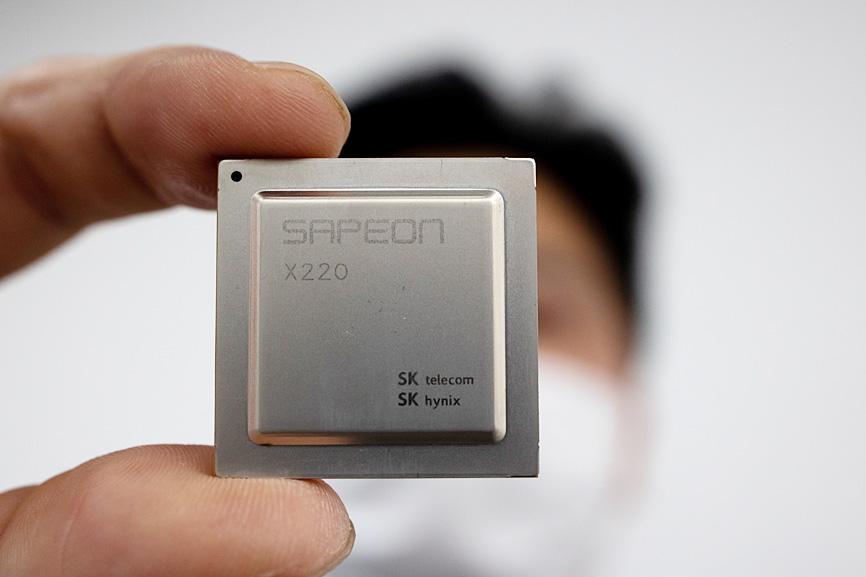South Korea is to add a new artificial intelligence (AI) chip to its arsenal of semiconductors as the nation seeks a bigger slice of the global technology market and an upgrade of its industrial capabilities.
The Sapeon X220, unveiled yesterday by the country’s largest carrier SK Telecom Co, is designed to speed up servers that cater to a growing number of mobile devices — from drones to self-driving vehicles — that perform better with AI.
It is the latest product of the nation’s decade-long push to broaden its dominance beyond memory chips, where Samsung Electronics Co and SK Hynix Inc control about two-thirds of the global market.

Photo: Bloomberg
Seoul sees data-processing chips as a major engine for economic growth, along with 5G wireless networks.
The government has provided more than 600 billion won (US$542. million) in support to develop the chips and plans to invest another 1 trillion won over the next decade, viewing them as crucial in automating factories and improving the competitiveness of the country’s exports.
“As we teamed up with the government, we said: ‘Let’s make AI available and affordable for all of our companies,’” SK Telecom vice president Lee Jong-min said. “South Korea has the demand, the full stack of tech needed to meet the demand, and the ability to take it to the next level.”
Semiconductors account for about one-fifth of South Korea’s exports, most of them memory chips.
The country is now turning to application-specific integrated circuits (ASICs), such as the X220, which is tailored for AI operations.
It follows a similar US$1 billion investment plan announced by the US government earlier this year, which also emphasized AI and public-private collaboration.
As the first country in the world to roll out commercial 5G last year, South Korea believes that it can also lead in adopting and optimizing AI, aided by the nation’s compact size, wide broadband coverage and smartphone penetration.
However, competition is heating up in the AI semiconductor sector, with the likes of Amazon.com Inc and Google holding company Alphabet Inc investing in their own bespoke server silicon.
As more devices than ever come online, companies are betting that they can unlock value and insights from the resulting trove of data through machine learning and analysis at scale.
Like SK Telecom, US competitors offer cloud services to other companies, and the investment in designing the chips makes sense when factoring in the cost of electricity and the chips’ ability to handle greater volumes of data more efficiently.
SK Telecom’s chip, at the size of a postage stamp, is the first South Korean ASIC for data centers to be commercialized, the company said.
It represents the latest push by the Seoul-based carrier to expand beyond its traditional mobile and broadband businesses, and keep up in an era of AI-driven innovation.
The global AI chip market is led by Nvidia Corp, a graphics-card giant whose market value has eclipsed that of Intel Corp.
Even smartphone processors from the likes of Apple Inc and Huawei Technologies Co (華為) now come with dedicated cores for handling AI tasks, and the need for more ASICs is forecast to rise as AI gains more ground in global technology.

CHIP RACE: Three years of overbroad export controls drove foreign competitors to pursue their own AI chips, and ‘cost US taxpayers billions of dollars,’ Nvidia said China has figured out the US strategy for allowing it to buy Nvidia Corp’s H200s and is rejecting the artificial intelligence (AI) chip in favor of domestically developed semiconductors, White House AI adviser David Sacks said, citing news reports. US President Donald Trump on Monday said that he would allow shipments of Nvidia’s H200 chips to China, part of an administration effort backed by Sacks to challenge Chinese tech champions such as Huawei Technologies Co (華為) by bringing US competition to their home market. On Friday, Sacks signaled that he was uncertain about whether that approach would work. “They’re rejecting our chips,” Sacks

NATIONAL SECURITY: Intel’s testing of ACM tools despite US government control ‘highlights egregious gaps in US technology protection policies,’ a former official said Chipmaker Intel Corp has tested chipmaking tools this year from a toolmaker with deep roots in China and two overseas units that were targeted by US sanctions, according to two sources with direct knowledge of the matter. Intel, which fended off calls for its CEO’s resignation from US President Donald Trump in August over his alleged ties to China, got the tools from ACM Research Inc, a Fremont, California-based producer of chipmaking equipment. Two of ACM’s units, based in Shanghai and South Korea, were among a number of firms barred last year from receiving US technology over claims they have

It is challenging to build infrastructure in much of Europe. Constrained budgets and polarized politics tend to undermine long-term projects, forcing officials to react to emergencies rather than plan for the future. Not in Austria. Today, the country is to officially open its Koralmbahn tunnel, the 5.9 billion euro (US$6.9 billion) centerpiece of a groundbreaking new railway that will eventually run from Poland’s Baltic coast to the Adriatic Sea, transforming travel within Austria and positioning the Alpine nation at the forefront of logistics in Europe. “It is Austria’s biggest socio-economic experiment in over a century,” said Eric Kirschner, an economist at Graz-based Joanneum

BUBBLE? Only a handful of companies are seeing rapid revenue growth and higher valuations, and it is not enough to call the AI trend a transformation, an analyst said Artificial intelligence (AI) is entering a more challenging phase next year as companies move beyond experimentation and begin demanding clear financial returns from a technology that has delivered big gains to only a small group of early adopters, PricewaterhouseCoopers (PwC) Taiwan said yesterday. Most organizations have been able to justify AI investments through cost recovery or modest efficiency gains, but few have achieved meaningful revenue growth or long-term competitive advantage, the consultancy said in its 2026 AI Business Predictions report. This growing performance gap is forcing executives to reconsider how AI is deployed across their organizations, it said. “Many companies